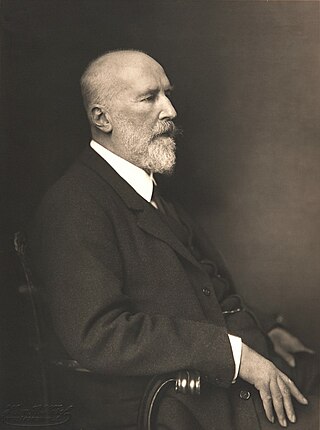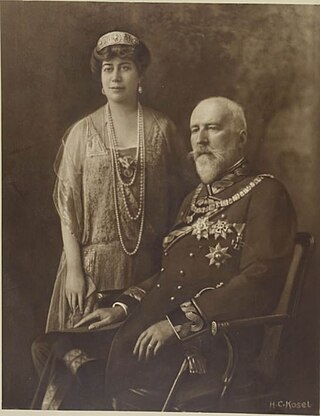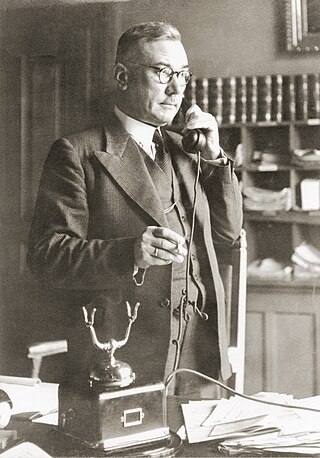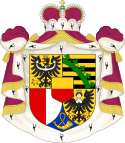
Political identity came to the territory now occupied by the Principality of Liechtenstein in 814, with the formation of the subcountry of Lower Rhætia. Liechtenstein's borders have remained unchanged since 1434, when the Rhine established the border between the Holy Roman Empire and the Swiss cantons.
The grand ducal family of Luxembourg constitutes the House of Luxembourg-Nassau, headed by the sovereign grand duke, and in which the throne of the grand duchy is hereditary. It consists of heirs and descendants of the House of Nassau-Weilburg, whose sovereign territories passed cognatically from the House of Nassau to the House of Bourbon-Parma, itself a branch of the Spanish royal house which is agnatically a cadet branch of the House of Capet that originated in France, itself a derivative dynasty from the Robertians and the Karlings and the founding house of the Capetian dynasty.

Johann II, nicknamed the Good, was Prince of Liechtenstein from 12 November 1858 until his death in 1929.

Joseph Johann Adam was the Prince of Liechtenstein from 1721 to his death.

Josef Wenzel I, often referred to as just Wenzel, was the Prince of Liechtenstein between 1712 and 1718, and 1748 and 1772, as well as regent of Liechtenstein between 1732 and 1745. He first succeeded his distant cousin Hans-Adam I, even though he was not next in line. The actual heir was his uncle Anton Florian, who was not very popular among the family. Therefore Hans-Adam chose Josef Wenzel as his heir. He later decided to hand over the Principality in exchange for his getting the Dominion of Rumburk in 1718. Thirty years later he inherited Liechtenstein again after his nephew Prince Johann Nepomuk Karl died without male issue. As a military figure, Wenzel is known for his command of the Austrians at the Battle of Piacenza.

Succession to the British throne is determined by descent, sex, legitimacy, and religion. Under common law, the Crown is inherited by a sovereign's children or by a childless sovereign's nearest collateral line. The Bill of Rights 1689 and the Act of Settlement 1701 restrict succession to the throne to the legitimate Protestant descendants of Sophia of Hanover who are in "communion with the Church of England". Spouses of Catholics were disqualified from 1689 until the law was amended in 2015. Protestant descendants of those excluded for being Roman Catholics are eligible.

Franz Joseph II was the reigning Prince of Liechtenstein from 25 July 1938 until his death in November 1989.

The Jacobite succession is the line through which Jacobites believed that the crowns of England, Scotland, and Ireland should have descended, applying male preference primogeniture, since the deposition of James II and VII in 1688 and his death in 1701. It is in opposition to the legal line of succession to the British throne since that time.

From the year 1340 to 1802, excluding two brief intervals in the 1360s and the 1420s, the kings and queens of England and Ireland also claimed the throne of France. The claim dates from Edward III, who claimed the French throne in 1340 as the sororal nephew of the last direct Capetian, Charles IV. Edward and his heirs fought the Hundred Years' War to enforce this claim, and were briefly successful in the 1420s under Henry V and Henry VI, but the House of Valois, a cadet branch of the Capetian dynasty, was ultimately victorious and retained control of France, except for Calais and the Channel Islands. Following the Hundred Years War, English and British monarchs continued to call themselves kings of France, and used the French fleur-de-lis as their coat of arms, quartering the arms of England in positions of secondary honour. This continued until 1802 when Britain recognised the French Republic and therefore the abolition of the French monarchy. The Jacobite claimants, however, did not explicitly relinquish the claim.

Franz I was Prince of Liechtenstein from 11 February 1929 until his death in 1938.

The House of Liechtenstein, from which the principality takes its name, is the family which reigns by hereditary right over the principality of Liechtenstein. Only dynastic members of the family are eligible to inherit the throne. The dynasty's membership, rights and responsibilities are defined by a law of the family, which is enforced by the reigning prince and may be altered by vote among the family's dynasts, but which may not be altered by the Government or Parliament of Liechtenstein.

Princess Margaretha of Liechtenstein is the fourth child and second and youngest daughter of Grand Duke Jean of Luxembourg and Princess Joséphine-Charlotte of Belgium. As the sister of Grand Duke Henri of Luxembourg and the sister-in-law of Prince Hans-Adam II of Liechtenstein, she is a princess of two current realms and a member of the Luxembourg and Liechtenstein reigning dynasties.

Succession to the Liechtensteiner throne is governed by the house laws of the Princely Family of Liechtenstein, which stipulate agnatic primogeniture. In 2004, the head of state, Hans-Adam II, publicly responded to criticism from a committee of the UN which had voiced concerns about the exclusion of women from the line of succession, stating that the rule was older than the state itself.

Prince Alois of Liechtenstein was the son of Prince Alfred of Liechtenstein (1842–1907) and Princess Henriette of Liechtenstein (1843–1931), daughter of Alois II of Liechtenstein.
The current line of succession to the Chrysanthemum Throne is based on the Imperial Household Law. At present, only direct male-line males are allowed to ascend the throne.

Archduchess Elisabeth Amalie of Austria was a daughter of Archduke Karl Ludwig of Austria and his third wife Infanta Maria Theresa of Portugal. She was the mother of Franz Joseph II, Prince of Liechtenstein, and the paternal grandmother of Hans-Adam II, Prince of Liechtenstein.

Elisabeth Sarolta "Elsa" von Gutmann was Princess of Liechtenstein from 1929 to 1938 as the wife of Prince Franz I of Liechtenstein.

Alois, Hereditary Prince of Liechtenstein is the eldest son of Hans-Adam II, Prince of Liechtenstein, and Countess Marie Kinsky von Wchinitz und Tettau, and the heir apparent to the throne of Liechtenstein. Alois has been regent of the country since 15 August 2004, while his father remains the official head of state.

General elections were held in Liechtenstein on 4 April 1939. Although a new system of proportional representation had been introduced to pacify voters at a time when the country was under threat from neighbouring Nazi Germany, it was not used and the elections became known as the "silent elections" as no actual vote was held. Instead, the governing Progressive Citizens' Party and opposition Patriotic Union formed a coalition, assigning a roughly equal number of seats each, in order to prevent the German National Movement in Liechtenstein from acquiring any seats in the Landtag.

Franz Josef Hoop was a Liechtensteiner diplomat and politician who served as Prime Minister of Liechtenstein from 1928 to 1945. Hoop is best known for his efforts to retain Liechtenstein's neutrality and independence during World War II. Serving for seventeen years, he is the longest-serving prime minister in the country's history, ahead of his successor Alexander Frick by 79 days. He served under the reign of Johann II, Franz I and Franz Joseph II, making him the only prime minister to serve under three Princes of Liechtenstein consecutively.

















